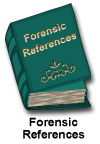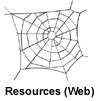|
|
 |
The
required readings for this unit are:
 Australia
Australia |
Required
Reading(s)
|
 |
Insert article
here
 Canada
Canada |
Required
Reading(s)
|
 |
Insert article
here
 International
International |
Required
Reading(s)
|
 |
Insert article
here
 United Kingdom
United Kingdom |
Required
Reading(s)
|
 |
Insert article
here
 United States
United States |
Required
Reading(s)
|
 |
McKoy, Y. D. (2002, October/November). Forensic nursing:
A challenge for nursing education. Forensic Nurse
Magazine. Retrieved October 15, 2002, from
http://www.forensicnursemag.com/articles/2a1feat5.html
- The
growing interest in forensic nursing as a nursing
subspecialty is not by happenstance. Increased reports
of violent acts are a constant reminder of the violence
in our society. Violence is a multifaceted problem
that is intimately interwoven into our relationships,
homes, schools, workplaces and communities. The
individuals seen by forensic nurses primarily are
victims of violence, but they may also be perpetrators,
survivors, individuals falsely accused of violent
acts, or as one patient put it, an "overcomer"
of violence. Consequently, the responsibilities,
roles and functions of the forensic nurse are in
part the nursing profession's response to the sequelae
of criminal and interpersonal violence in society.
Winfrey, M., & Smith, A. R. (1999).The suspiciousness
factor: Critical care nursing and forensics. Critical
Care Nursing Quarterly, 22(1), 1-7. Retrieved December
12, 2002, from Academic Search Premier database: http://search.epnet.com/direct.asp?an=6822489&db=aph
- As nursing
education moved into the university, the intellectual
basis of the discipline was examined.
|
Databases
For the full text article online,
sleuth the 'University
of Calgary/ Library/ Article Indexes':
Directions:
- Select
- Indexes and abstracts with links to full text articles
- Select
- Academic Search Premier or Expanded Academic ASAP
- Select
- Connect
-
Fill in
User ID and Pin
- Fill
in search words:
- forensic*
and nursing and education
- forensic*
and _________________
Top of Page
|
 |
 |
The
'recommended only' readings for this unit are the following:
 Australia
Australia |
Recommended
Reading(s)
|
 |
Dhondea, R. (1995).
An ethnographic study of nurses in a forensic psychiatric
setting: Education and training implications. Australia
and New Zealand Journal of Mental Health Nursing, 4,
77-82.
- Note this
study was an attempt to make sense of what nurses do in
forensic psychiatric settings and to identify their educational
needs.
Roberts, G. L.,
Raphael, B., & Lawrence, J. M. (1997). Impact of an
education program about domestic violence on nurses and
doctors in an Australian emergency department. Journal
of Emergency Nursing, 23(3), 220-227.
- Note: Further
research is needed into the beliefs and practices of nurses
and doctors about domestic violence. The impact of this
education program highlights the necessity for introducing
training programs for health professionals on domestic
violence problems. (J Emerg Nurs 1997;23:220-7)
 Canada
Canada |
Recommended
Reading(s)
|
 |
Insert article/book/chapter
here
 International
International |
Recommended
Reading(s)
|
 |
Kent-Wilkinson,
A., Mckeown, M., Mercer, D., McCann, G. & Mason, T.
(1999). Practitioner Training, Future Directions, and Challenges
for Practice. pp. 351-358. In Mercer, D., Mason, T., Mckeown,
M. & McCann, G. [Eds] (1999). Forensic mental health
care: A case study approach. Churchill Livingstone,
Edinburgh. ISBN 0-443-06140-8
- Note four
brief cases of different education initiatives which exemplify
various aspects of meeting forensic training needs from
Canada and the United Kingdom. Also note this historical
overview of education.
 United Kingdom
United Kingdom |
Recommended
Reading(s)
|
 |
Insert article/book/chapter
here
 United States
United States |
Recommended
Reading(s)
|
 |
Goldkuhle, U.
(1999). Professional education for correctional nurses:
A community based partnership model. Journal of Psychosocial
Nursing, 37 (9), 38-44.
- Note that
advanced, professional education is the key to shift the
correctional health nursing role from isolated practice
behind bars to a seamless, community based, managed care
approach (Goldkuhle, 1999, p. 38).
McKoy, Y. D.
(2002, October/November). Forensic nursing: A challenge
for nursing education. Forensic Nurse Magazine. Retrieved
October 15, 2002, from
http://www.forensicnursemag.com/articles/2a1feat5.html
- The growing
interest in forensic nursing as a nursing subspecialty
is not by happenstance. Increased reports of violent acts
are a constant reminder of the violence in our society.
Violence is a multifaceted problem that is intimately
interwoven into our relationships, homes, schools, workplaces
and communities. The individuals seen by forensic nurses
primarily are victims of violence, but they may also be
perpetrators, survivors, individuals falsely accused of
violent acts, or as one patient put it, an "overcomer"
of violence. Consequently, the responsibilities, roles
and functions of the forensic nurse are in part the nursing
profession's response to the sequelae of criminal and
interpersonal violence in society.
Winfrey, M. (1998).
Using forensic autopsies to teach advanced pathophysiology.
Clinical Nurse Specialist, 12 (5), 192-197
- Note the
benefits of using forensic autopsies to teach advanced
pathophysiology.
Top of Page
|

|
Additional
references for this unit can be found in 'forensic
references'
of the forensic sourcebooks.
Top of Page
|

|
Video's
recommended for this unit are:
|
|
Resources
(Video)
|
 |
Insert video
here
Top of Page
|

|
 |
Sleuth
the following websites for this unit:
International
Association of Forensic Nurses (2000). Position Statement
on Forensic Education (10/2002). IAFN Website. Retrieved
June 15, 2002, from http://www.forensicnurse.org
- Note - the
position statement on forensic education.
 Australia
Australia |
Resources
(Web)
|
 |
Insert website
here
 Canada
Canada |
Resources
(Web)
|
 |
Harvey, P. (1998).
MRC Forensic Education Research Online-Study 2A. Mount Royal
College. Retrieved June 23, 2002 from MRC Website: http://www.mtroyal.ab.ca/olt/
- Note what
technical and content design characteristics affect student
learning outcomes when instructional technologies are
utilized on-line in the delivery of distance education
in forensic nursing.
- This was
an MRC contracted study done on the Forensic courses I
developed and teach at Mount Royal College.
Kent-Wilkinson,
A. (1998, April). Forensic Education International. Retrieved
June 14, 2002 from The Forensic Education Website: http://www.forensiceducation.com/forensic_files/edu_internationally.htm
- Note the
link to forensic education international.
 International
International |
Resources
(Web)
|
 |
Insert website
here
 United Kingdom
United Kingdom |
Resources
(Web)
|
 |
Insert website
here
 United States
United States
|
Resources
(Web)
|
 |
Insert article
here
Top of Page
|
 |
For
additional websites on this unit, sleuth 'forensic
websites' in the forensic sourcebooks.
- forensic - nursing - education - international
Top of Page
|
 |
|